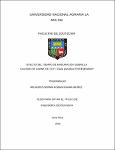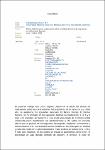Mostrar el registro sencillo del ítem
Efecto del tiempo de maduración sobre la calidad de carne de cuy (Cavia porcellus) Post faenado
| dc.contributor.advisor | Vargas Morán, Jorge Rafael | |
| dc.contributor.advisor | Elías Peñafiel, Carlos César Augusto | |
| dc.contributor.author | Kobashigawa Muñoz, Milagros Norma | |
| dc.date.accessioned | 2017-10-10T17:33:04Z | |
| dc.date.available | 2017-10-10T17:33:04Z | |
| dc.date.issued | 2016 | |
| dc.identifier.other | Q04.K6-T BAN UNALM | |
| dc.identifier.uri | https://hdl.handle.net/20.500.12996/2858 | |
| dc.description | Universidad Nacional Agraria La Molina. Facultad de Zootecnia. Departamento Académico de Producción Animal | es_PE |
| dc.description.abstract | El presente trabajo tuvo como objetivo determinar el efecto del tiempo de maduración sobre las características físico-químicas de la carne de cuy. Para ello, se analizaron los siguientes músculos: El Biceps femoris, El Rectus femoris, de 75 animales en los siguientes tiempos de maduración: 1, 3, 6 y 9 días. Los animales se faenaron a una edad aproximada de 3 meses (edad comercial) previo aturdimiento por electronarcosis a 156 voltios de corriente alterna por un período de 10 segundos, desangrado, depilados, eviscerados y almacenados a 4°C. Los animales fueron divididos en tres lotes para su análisis y cada lote contó con cuatro tratamientos. Estos análisis se realizaron al 1,3,6 y 9 días post beneficio, en los cuales se evaluaron parámetros como el pH, el porcentaje de jugo liberado (método de presión), la terneza, el color en diferentes músculos y análisis microbiológicos. Se observó que la carne de cuy disminuye su pH de 6,10 a 6,01 inicialmente, para luego incrementarlos hasta 6,23 al día 9 de maduración. De igual forma, la terneza aumenta, indicado por la disminución de la fuerza de corte, observándose un cambio significativo entre el primer y tercer día de maduración, luego del cual existe un pequeño aumento no significativo. Los resultados, obtenidos van de 3,11 kg/cm2 a 2,13 kg/cm2. En cambio el porcentaje de agua liberada mostró una tendencia a aumentar, obteniéndose resultados de 25,30% a 32,44% y durante los seis primeros días existió una pérdida significativa. Por otra parte, la carne mostró una tendencia al oscurecimiento, ya que la luminosidad tanto para el Biceps femoris y la zona del peritoneo disminuyeron, obteniendo resultados de 52,99 a 50,74 t 51,84 a 51,22 respectivamente en porcentaje de luminosidad. Estos resultados nos indicaron que si existe un efecto del tiempo de maduración sobre las características físico-químicas de la carne de cuy, aunque éste no haya sido significativo en algunos parámetros como en la terneza y el color, a diferencia del pH y el porcentaje de jugo liberado en el que se observaron significancia estadística. En lo que respecta al análisis microbiológico, desde el día 6 de maduración se detectó la presencia de microorganismos mesófilos aerobios en cantidades superiores a las clasificadas como aceptables, pero entrando en la clasificación de marginalmente aceptable, es decir, no son deseables pero pueden ser admitidas, a diferencia de la presencia de Salmonella sp. que resultó negativa para todos los tratamientos. Todo según la referencia hecha por DIGESA. | es_PE |
| dc.description.abstract | The present study aimed to determine the effect of the postmortem ageing time on the physicochemical characteristics of guinea pig meat. For that were analized the following muscles: The Biceps femoris, the Rectus femoris, of 75 animals in the following days of storage: 1, 3, 6 and 9 days. The animal were acquired to an approximate age of 3 months (commercial age) previous electro stunning 156 volts of alternating current for a period of 10 seconds, bled out, depilated, gutted and stored at 4°C. The animals were divided into three batches for analysis, and each lot featured four treatments. These analyses were conducted at 1,3,6, and 9 days post benefit, which analyzed parameters such as pH, juice released percent (pressure method), the tenderness, the color of different muscles and microbiological analysis. It was observed that Guinea pig meat decreases its pH from 6,01 to 6,10 initially to then increase it up to 6,23 at 9 day of ageing time. Similarly, the tenderness also increases, indicated by the decrease of the shearing force, noting a significant change between the first and third days of storage, after which there is a small non-significant increase, the results obtained goes from 3,11 kg/cm2 to 2,13 kg/cm2. In contrast the percentage of releases water showed a tendency to increase, obtained results from 25.30% to 32,44% during the first six days of ageing time was a significant loss. On the other hand, the meat showed a trend to darkening because the luminosity for the Biceps femoris and the peritoneum area decreased, obtaining results from 52,99 to 50,74 and 51,84 to 51,22 respectively in brightness percentage. These results showed us that exists an effect of the postmortem ageing time on physicochemical characteristics of guinea pig meat, this has not been significant in some parameters such as tenderness and color, unlike the pH and the juice released percent that statistical significance were observed. With regard to microbiological analysis, from day 6 of postmortem ageing time was detected the presence of microorganisms aerobic mesophyll in quantities greater than those classified as acceptable, but entering in the classification of marginally acceptable, it means, it is not desirable but may be admitted, as opposed to presence of Salmonella sp. That result negative for all treatments, according to the reference made by DIGESA. | en_US |
| dc.description.uri | Tesis | es_PE |
| dc.format | application/pdf | en_US |
| dc.language.iso | spa | es_PE |
| dc.publisher | Universidad Nacional Agraria La Molina | es_PE |
| dc.rights | info:eu-repo/semantics/openAccess | en_US |
| dc.rights.uri | https://creativecommons.org/licenses/by-nc-nd/4.0/ | * |
| dc.source | Universidad Nacional Agraria La Molina | es_PE |
| dc.source | Repositorio institucional - UNALM | es_PE |
| dc.subject | Post Faenamiento | es_PE |
| dc.subject | Faenamiento | es_PE |
| dc.subject | Tiempo de maduración | es_PE |
| dc.subject | Cuyes | es_PE |
| dc.subject | Carne de Cuy | es_PE |
| dc.subject | Cobaya | es_PE |
| dc.subject | Calidad de la carne | es_PE |
| dc.subject | Procesamiento | es_PE |
| dc.subject | Sacrificio | es_PE |
| dc.subject | PH | es_PE |
| dc.subject | Capacidad de retención de agua | es_PE |
| dc.subject | Ternura | es_PE |
| dc.subject | Color | es_PE |
| dc.subject | Evaluación | es_PE |
| dc.subject | Perú | es_PE |
| dc.title | Efecto del tiempo de maduración sobre la calidad de carne de cuy (Cavia porcellus) Post faenado | es_PE |
| dc.type | info:eu-repo/semantics/bachelorThesis | en_US |
| thesis.degree.discipline | Producción Animal | es_PE |
| thesis.degree.grantor | Universidad Nacional Agraria La Molina. Facultad de Zootecnia | es_PE |
| thesis.degree.name | Ingeniero Zootecnista | es_PE |
| thesis.degree.level | Título Profesional | es_PE |
| dc.subject.ocde | https://purl.org/pe-repo/ocde/ford#2.11.01 | es_PE |
Ficheros en el ítem
Este ítem aparece en la(s) siguiente(s) colección(ones)
-
ZOO-PA Tesis [154]




